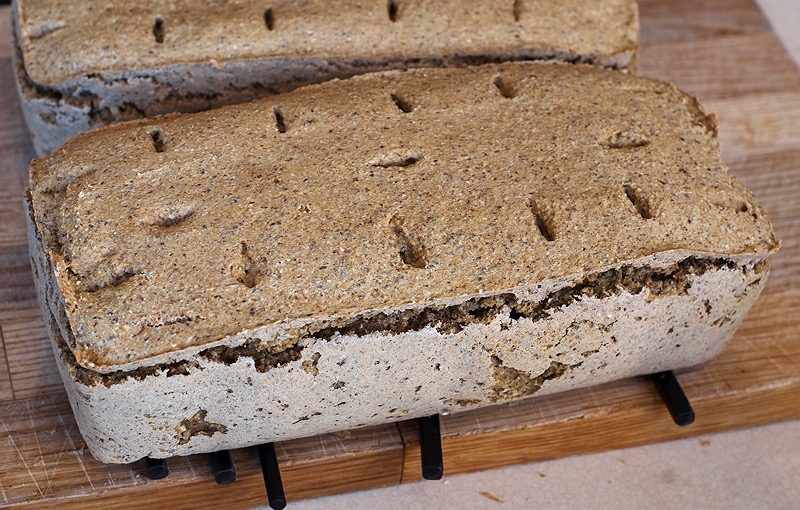Thet's Oat Bread
In this picture the bread is still hot from the oven. The crack in the side of the top reduces as it cools.
I don't get on with wheat, and I dislike all the commercial wheat-free breads I have tried, usually full of empty starches derived from tapioca or potatoes, and generally lacking in taste and texture. They are also usually overpriced.
So here's my multigrain oat bread recipe. It makes two solid loaves in standard sized bread tins.
Ingredients
1Kg fine oatmeal
Oats are a great staple. Long lasting carbs, beneficial oils, high fibre, and high protein (for a grain)
150g buckwheat flour
Adds a slight nutty flavour and is finer in texture than the oatmeal so adds some filler to the texture
150g chia seeds
Adds texture, acts as a binder when the seeds do that gelling thing they do with water, and is really nutritious and high fibre.
200g ground linseed
You can use brown or golden linseed, or a mixture. I grind it in a coffee grinder since it is much cheaper to buy whole linseeds than ground. Adds more texture and colour, and a generally rustic and wholesome feel to the bread. Also nutritious and high fibre.
7g xanthan gum
Glues it all together. Without this the bread will tend to be excessively crumbly.
5g guar gum.
Optional. Maybe increase the xanthan a little if leaving it out. Adds a bit more binding and also moisture retention. Not as effective a glue as xanthan, but too much xanthan can create a slimy feel, so I use some of each gum.
8g sodium bicarbonate
Makes it rise just a tiny bit. If you leave it out the texture will be more like a very solid cake, but I am going for a very dense bread.
2g ascorbic acid (vit C) powder - and/or 5ml lemon juice.
The bicarb needs a bit of acid to work. I haven't calculated the optimum amounts but this seems to work.
approx 1.2 litres of water
The amount needed will vary depending on whether you have changed any of the proportions of the ingredients, and how finely they are ground.
Method
Put all the dry ingredients in a bowl and mix thoroughly while dry.
Preheat the oven to about 160C
Add the water gradually to a hole in the middle of the dry ingredients, and mix into an expanding ball of dough. Mix as fast as possible as the xanthan and chia will make it all very sticky quite fast. This requires a bit of strength. The quantities I have chosen are about the maximum I can mix at a time, and also suit a large mixing bowl (I use a large cast iron Le Creuset-style pot.)
Add water and stir thoroughly until the mess you've made becomes a very wet sticky dough, or perhaps an exceptionally thick batter.Scoop the dough into the loaf tins/moulds pressing it into the corners and together to avoid air bubbles as best you can. This is quite difficult. I find using a wet flat wooden spatula works ok.
Once the dough is pressed into the moulds, you might want to pierce the top of the loaf to a depth of about 3cm and 5cm intervals with a thin flat knife (wet it first). The allows the vapour to escape as it bakes and goes some way towards preventing the top of the loaf breaking off as the water evaporates.
Bake for 1 hour at 160C. Adjust this according to your oven and your initial results.
When you remove the bread from the oven it may look like the top of the loaf is trying to break away with a big crack down one or both sides - if you let the loaf sit for 30 mins before disturbing it further this will settle and largely reattach itself.
I'm no baking expert, and this is work in progress, but I eat this bread every day and it works for me!

